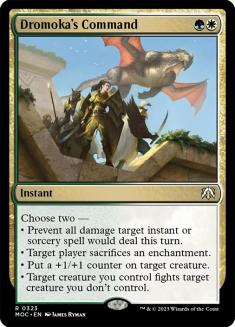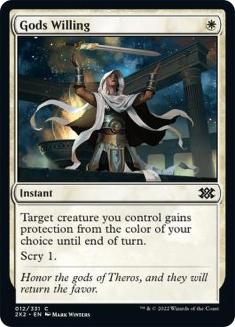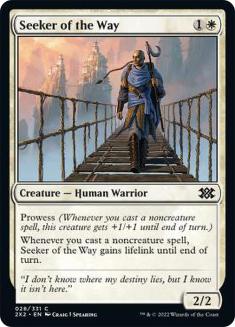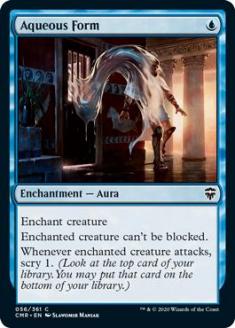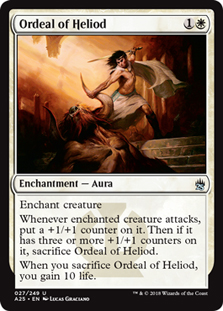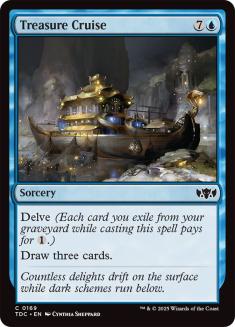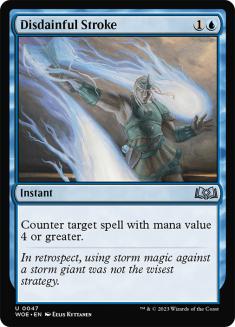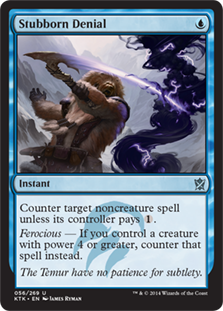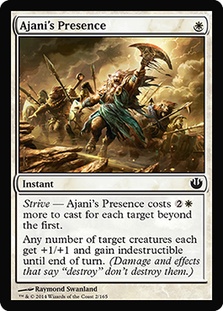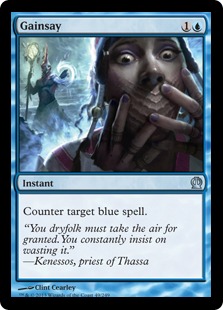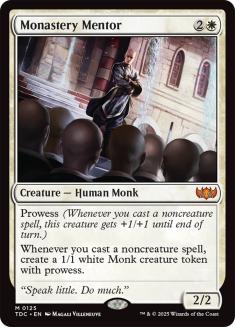Power versus consistency.
The struggle has gone on for over twenty years now across all formats. Some call more colors greedy. Some call it foolish. A fifteen-land, four-color Draft
deck with eight rares will certainly be powerful, but will it be functional?
The greatest flaw in Magic is the existence of mana flood and mana screw. The push from Wizards of the Coast for midrange strategies is a good one.
Standard is full of three-color decks with a bunch of mythic rares and 24 lands, with enough of those lands being of the Temple cycle, which mitigates both
land flood and screw. Wizards has made sure that, in Standard, in most games you get to play a good bit of Magic.
While true three-color decks have been doing well, like Abzan Aggro, Jeskai Tokens, and Sultai Reanimator, there has been an uptick in three-color decks
that only splash a third color. Standard seems to be moving into an era of light splashes, whether it be for a light third or a light fourth like out of
Abzan/Sultai Reanimator for Dragonlord Atarka. Even Mono-Red has incorporated a light splash for Atarka’s Command, weighing the power increase as more
valuable than the cost of inconsistency and lost life from fetchlands and Mana Confluence.
Grand Prix Krakow had five Esper Dragons decks in its Top 8. Esper Dragons is basically U/B Control that splashes Dragonlord Ojutai off of just Haven of
the Spirit Dragon, Temple of Enlightenment, and perhaps a couple other lands. Sam Pardee made top 8 as well, piloting Bant Megamorphs. His blue splash was
minimal, only for Dragonlord Ojutai maindeck and some sideboard cards. The theory here is to have a solid, consistent game 1, then after the games slow
down post-sideboard, you have more time to find a third color.
The lesser known ninth-place finisher, Jan Ksandr, played Bant Heroic, a deck that I’ve been advocating the past couple of weeks. His list was different
from the list I posted in ” Is Bant Heroic Broken?” where he opted for
Heliod’s Pilgrim instead of Monastery Mentor. His changes inspired me to give the Pilgrims another chance, and I ended up playing an experimental Bant
Heroic build at the Open Series in Cleveland this past weekend. All in all though, I was surprised by the results from Europe. It seems that they often do
their own things and don’t weigh American results (in particular, StarCityGames results) too heavily.
I’ve gotten a lot of messages these past few weeks about people winning their Game Day, States, or a PTQ. Tommy Ashton won the Magic Online PTQ with the
exact 75 from that article. Ross Merriam won SCG Cleveland with a very close list as well. I’ve never personally seen a mirror, and I doubt that there are
many total people playing the deck, but it seems to be having good finishes. I wonder if the deck was known about earlier and competitors had more time to
test if it would have shown up more at Pro Tour Dragons of Tarkir.
Why don’t more people play Bant Heroic?
The strategy seems very linear and exploitable. For a while, when Chained to the Rocks was common, W/U Heroic wasn’t very good. Jeskai Aggro made a
comeback too, where both Wild Slash and Mantis Rider gave Heroic trouble. Many are still of the “Heroic sucks” mentality. With the mentioned cards
appearing in fewer numbers and with the addition of the powerhouse Dromoka’s Command, Bant Heroic fares well against the field.
Three types of games will exist: Games you don’t get to play Magic. Games they don’t get to play Magic. And the good, interactive games where both sides
get to play Magic. Of the first two, you run them over more often than vice versa. Where Heroic was weak in the third category, Dromoka’s Command and
sideboard options shore that up.
Bant Heroic will never be a deck that appeals to everybody. People don’t like the way it loses. People don’t like the way it wins. It can come off as a
cheesy and childish strategy. Whatever the case me be, I’m happy with it still flying just below the radar.
This is what I played at SCG Cleveland this past weekend.
Creatures (18)
- 2 Battlewise Hoplite
- 4 Favored Hoplite
- 4 Hero of Iroas
- 2 Lagonna-Band Trailblazer
- 2 Heliod's Pilgrim
- 3 Seeker of the Way
- 1 Monastery Mentor
Lands (22)
Spells (20)

What about Esper Dragons? How does this deck beat a Foul-tongue Invocation?
The theory was that Heliod’s Pilgrim was the answer I was looking for against Foul-Tongue Invocation to both put another body into play but not overcommit
into Crux of Fate. Largely, the plan worked out, as I faced Esper Dragons three times in the tournament and didn’t drop any game 1s. The cost was that the
deck became weaker to aggro overall with its slower toolbox package and higher curve.
Dromoka’s Command sucks against Esper Dragons game 1, but it is still a serviceable “half-a-card”. It’s the one matchup where Dromoka’s Command doesn’t get
maximum value and has been a concern among people interested in trying out Bant Heroic. Since that’s the case, I reworked the maindeck to better react to a
higher expectancy of Esper Dragons.
Esper Dragons is undoubtedly tough, and it will show up in high numbers, as it is the current consensus best deck. This is how I sideboarded against them
in Cleveland.
Out:
In:
With Ross Merriam’s build (which I recommend going forward),
I’d sideboard like this.
Out:
In:
Enough about Bant Heroic for now. Let’s poke around to see if other light splash options could work.
Chris VanMeter pioneered the G/R Dragons deck at SCG Syracuse, and it’s been putting up solid numbers in the last week weeks of tournaments. I know that he
switched his maindeck Ashcloud Phoenixes with Arbor Colossi as a way to have a better mirror matchup at the States we went to in West Virginia. Afterward,
he wasn’t really pleased with either option, and even Dromoka the Eternal was in the discussion as a possible replacement.
I played in a Sealed PPTQ on MTGO and had the privilege of having Whisperer of the Wilds and Sarkhan Unbroken in the same deck. The times that I got to
play Sarkhan on turn 4 felt really good, and both the +1 and -2 felt solid and reasonable for the cost of a five-mana planewalker, and especially so at
turn 4. This got me wondering why Sarkhan Unbroken hasn’t shown up in more Standard decks. The deck needed another card for the mirror to combat
Thunderbreak Regent and Stormbreath Dragon, and Sarkhan Unbroken fits the bill. It’s also a nice curve into Dragonlord Atarka with it’s +1.
Creatures (22)
- 4 Elvish Mystic
- 4 Sylvan Caryatid
- 4 Stormbreath Dragon
- 4 Courser of Kruphix
- 2 Dragonlord Atarka
- 4 Thunderbreak Regent
Planeswalkers (5)
Lands (24)
Spells (9)

Sarkhan Unbroken does a lot of small things, and it’s a shame that he can’t be cast off of nor returned with Haven of the Spirit Dragon. Although you can’t
reveal Sarkhan to Draconic Roar, he still puts 4/4 flying Dragons into play, which essentially ups your Dragon count, making for more potent Roars on
average. He a mix of ramp, card advantage, and a threat that historically has been the combination you’re looking for in a planeswalker. Heck, with four
Sylvan Caryatid, some Mana Confluences, and some Sarkhan Unbrokens, you could get away with casting cards off a fourth color pretty easily. Dromoka’s
Command, perhaps?
Or maybe Crackling Doom? Of course, jamming it into a Temur deck isn’t the correct place, but it indeed is the best removal spell that no one is playing
right now. When previously Wild Slash and Chained to the Rocks were the best, now Foul-tongue Invocation, Ultimate Price, Valorous Stance, Roast, and
Dromoka’s Command are the go-to removal choices.
Perhaps with the decline of Wild Slash, there could be a rise in a token strategy while being heavy with 2/2s. A light splash to the old R/W Aggro deck
could be something again.
Creatures (12)
Planeswalkers (2)
Lands (24)
Spells (22)

This is a take on Osyp Lebedowicz’s Mardu deck that he finished ninth with at GP Miami. He played Chained to the Rocks, but I don’t think that’s where you
want to be right now. Taking the core elements from the R/W Aggro deck and adding Sorin, Solemn Visitor and Cracking Doom feels really good. Crackling Doom
is definitely one of the best cards against Heroic, and with the rise of hexproof Dragons in the format with Silumgar, the Drifting Death and Dragonlord
Ojutai, Crackling Doom is ready to make a comeback as one of the best removal spells in Standard.
The number of Wild Slashes has been lowered in response to the more control-heavy metagame. While Foul-tongue Invocation makes a burn plan less appealing
overall, I really like how Crackling Doom plays against big untargetable Dragons. Sorin, Solemn Visitor is a big player too, as the +1 further pressures
Esper Dragons with your current creatures without overcommitting, and the -2 Vampire give you an opportunity to grind them out with a touch of card
advantage. The ultimate of Sorin, Solemn Visitor is unbeatable for Esper Dragons now as well.
What makes a light splash the way to go?
Many factors plague decks trying to reliably hit all of their colors as early as the third turn. Manabases end up painful, and their spells can’t be cast
on curve. Standard is chock full of powerful spells, and light splashes seem as easy as they’ve ever been given that there are Temple options of all
combinations. The fine balance between power level and consistency regarding castability of your spells currently seems to be with a gentle touch of a
neighboring color for a powerful rare or mythic.


